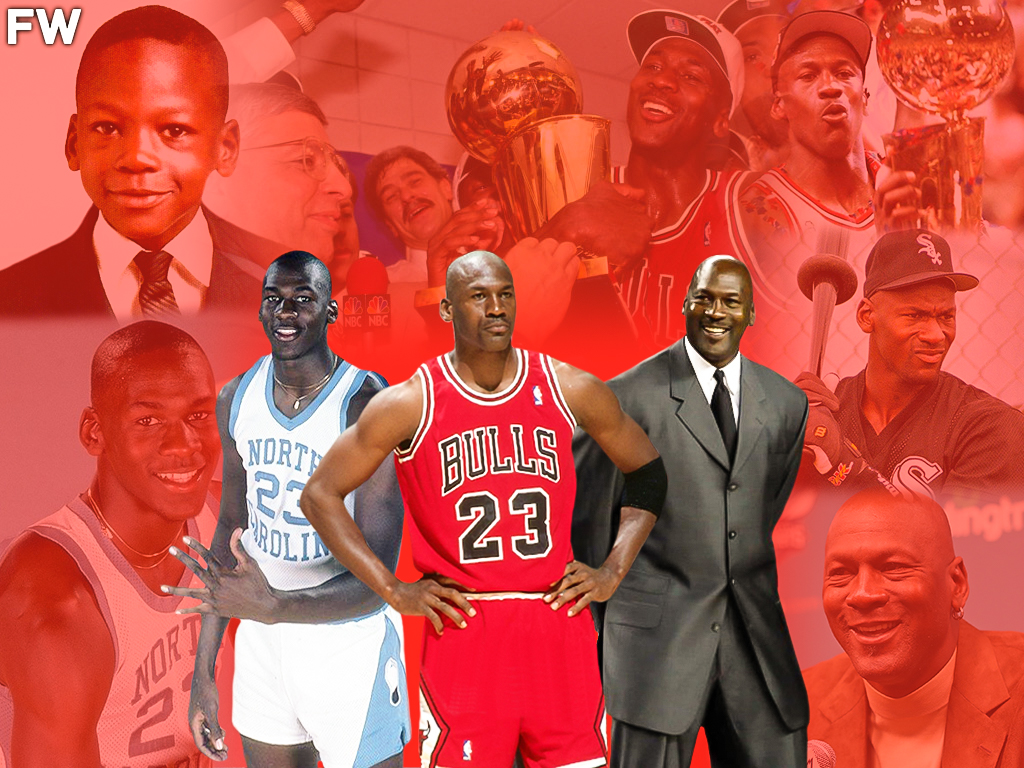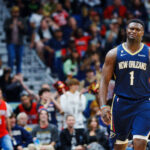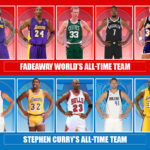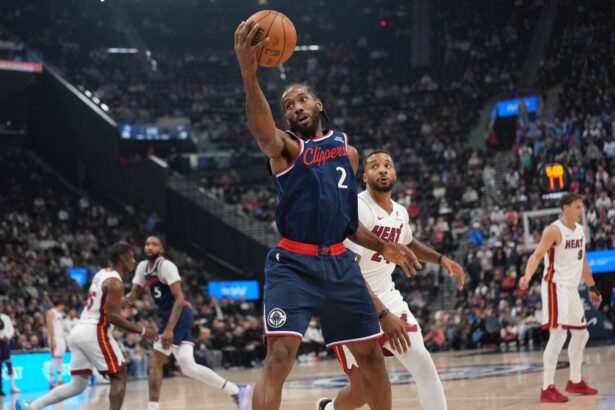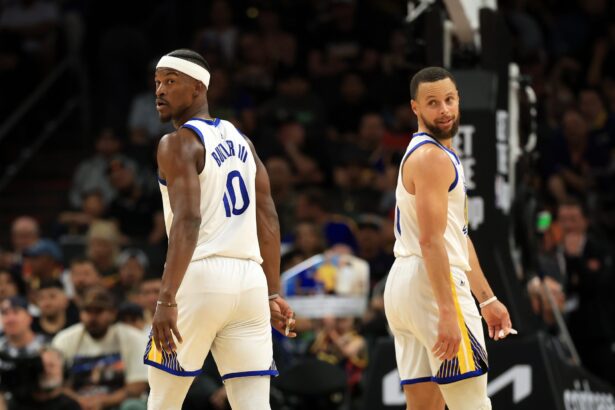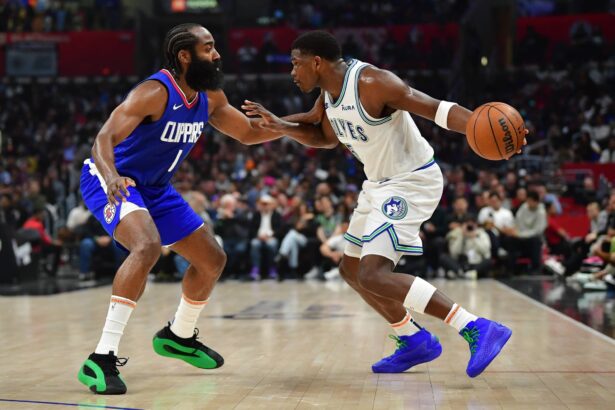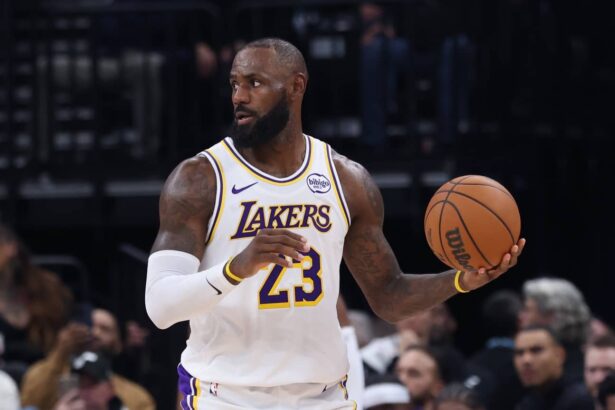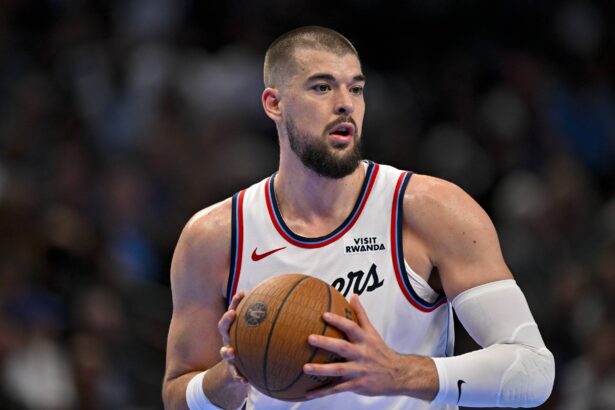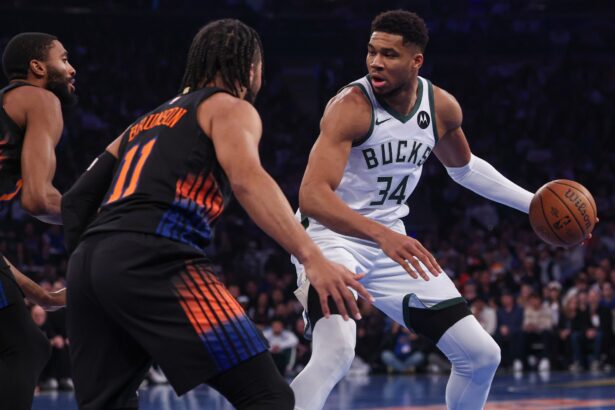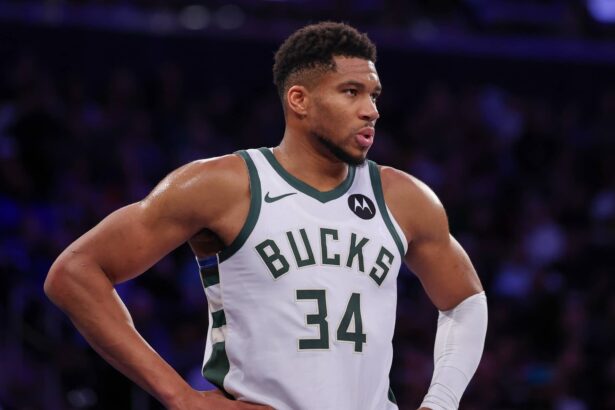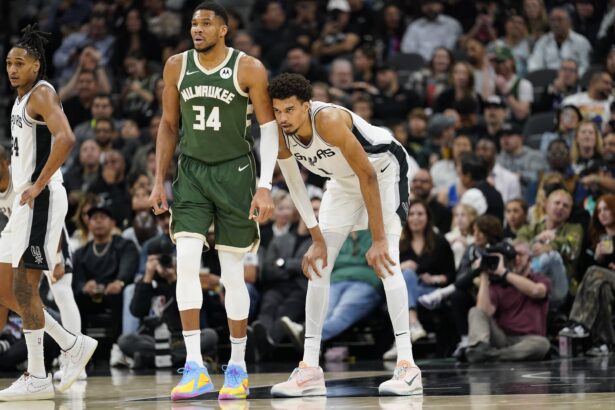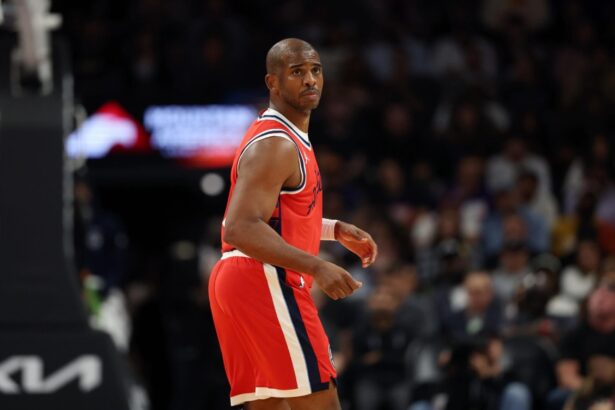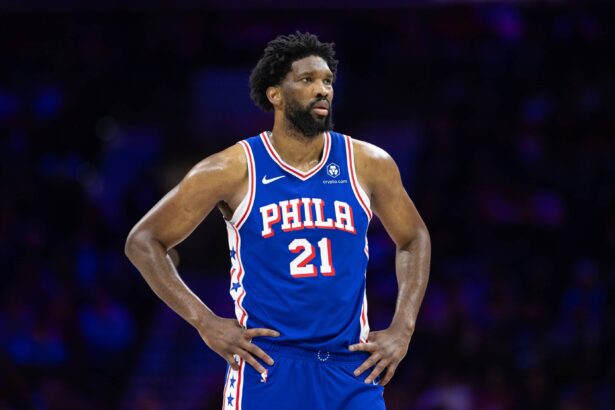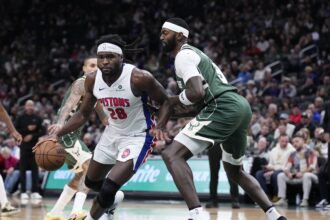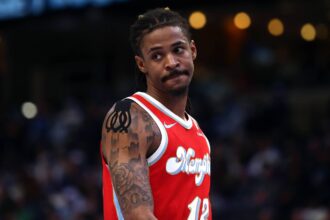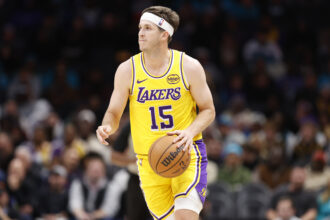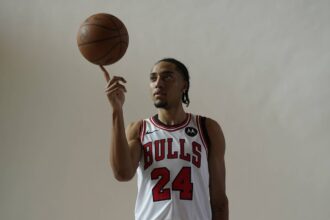It seems like every NBA fan, old and young, knows about Michael Jordan and his six NBA championships with six Finals MVPs. They also most likely know about his 1995-96 team that won 72 games and his famous flu game against the Utah Jazz.
- Michael Jordan: The Beginning
- Jordan Becomes A College Star
- Olympic Gold Medalist And NBA Rookie Of The Year
- An Injury, A Record-Setting Game, And An MVP For Jordan
- Jordan Breaks Through The Bad Boys Roadblock To Three-Peat
- A Shocking Retirement, Baseball, And A Second Three-Peat
- A Second Comeback And A Business Empire
Most also remember seeing Jordan in all sorts of commercials, from Hanes brand underwear to Gatorade. This includes the famous Jordan commercial that featured the song “Be Like Mike.”
These are the obvious stories of Michael Jordan, but do most fans know the complete story of the G.O.A.T.? There’s much more to MJ’s story. What made Jordan the ultimate competitor? How did he get into golf?
In this article, we’ll touch base on those questions and many more, like why Jordan stuck his tongue out while playing. Without further ado, Fadeaway World presents the biography of Michael Jordan.
Michael Jordan: The Beginning
The date was February 17, 1963, and the place was Brooklyn, New York, not North Carolina. This was the date and place where Michael Jeffrey Jordan was born.
Jordan was born to James and Deloris Jordan, and his parents would play a major role in his life and his journey into the game of basketball. James worked as a maintenance worker and manager at General Electric, while Deloris worked as a bank teller.
James and Deloris were from North Carolina but moved to Brooklyn, New York, so that James could study airplane hydraulics. Deloris was pregnant and gave birth to His Airness at Cumberland Hospital.
The young Jordan would stay in Brooklyn for only 18 months as his family moved back to Wilmington, North Carolina. This is where Jordan would start to build his legacy.
MJ was not an only child, as he grew up with four siblings: James Jr., Larry, Deloris, and Roslyn. Jordan would be particularly close to Larry, as the two developed a rivalry on the basketball court.
Jordan has spoken before about how Larry had the real basketball talent in the family and that Larry used to beat him regularly on their backyard basketball court.
Via Slam Online:
“Man, my older brother Larry used to kill me,” Jordan said. “He was older and bigger than me. He would beat me, talk to me and not let me forget about it. What that did for me was make me work that much harder to beat him. He had no idea that I was going to end up taller than him. I look at my games with him as a great experience when I was young, because I developed my love for the game and it made me work harder to get better.”
Jordan would develop his game against his brother Larry, but, as mentioned earlier, his parents played a big role in his development, as well. James would be the one who built Jordan his first basketball court in their backyard.
James also initially put Jordan in baseball, where the young G.O.A.T. would first learn the joy of competitive sports. Jordan attended Emsley A. Laney High School, where he played baseball, football, and of course, basketball.
As mentioned, Jordan’s father helped him become a better basketball player by building his first basketball court. How did his mother help him?
Back when Jordan was 12, he was constantly getting into fights at school. This led to Jordan being suspended from school, and Deloris decided she wasn’t going to let her son relax at home while watching some TV.
“He tells me it would be considered child abuse today,” Deloris said of her punishment with a laugh. “But it was a tough age and I knew I had to set the precedent. I took him to work and made him stay in the car all day and read. I could see him from the bank window. I wanted him to know I was always watching him. We went to lunch, and then after dinner, I knew a lady at the library, so he stayed there and read some more. We didn’t have any more trouble from him after that.”
This life lesson from Deloris taught MJ that he needed to straighten up if he wanted to play basketball in school. So, Jordan did straighten up, but he’d soon learn another valuable lesson from his mother after being cut from the school’s varsity basketball team.
As a 15-year-old sophomore, Jordan was skinny and only stood at the height of 5’10”. When Jordan tried out for the varsity team, he was promptly cut, mainly because of his size.
Jordan’s friend, Leroy Smith, stood 6’7”, and he would be selected to the team as the only sophomore on the roster. This hurt Jordan, who believed he deserved the spot over Smith.
After being cut, Jordan rushed home and locked himself in his room. He proceeded to cry as the pain of rejection was too unbearable for him to handle.
When Deloris came home from work, she discovered her son crying in his room. There, she taught Jordan the biggest lesson of his young life.
“We both cried, ’cause I knew he wanted to really compete with the other guys,” Deloris said. “My words to him was, ‘if you really want it, you work hard over the summer,’ and he did that summer!”
Being cut was what fueled that competitive spirit we’ve all come to know. After taking his mother’s advice, Jordan developed his game on the junior varsity team, and over the summer, MJ came back with a vengeance the following year. Jordan not only made the varsity team, but he quickly became a star.
After his junior season, where he averaged 24.8 points per game, Jordan was invited to Howard Garfinkel’s Five-Star Basketball Camp. There, MJ would take on other top high school prospects, and he’d catch the eye of North Carolina Tar Heels head coach Dean Smith.
As a senior, Jordan averaged 26.8 points, earning a spot in the 1981 McDonald’s All-American Game. In this game, Jordan showcased his talent some more, scoring 30 in the game.
Many top colleges recruited His Airness, but Jordan wanted to stay close to home. He chose North Carolina, and this decision would prove to be the right one.
Jordan Becomes A College Star
Michael Jordan joined a North Carolina team that had plenty of other solid players on the squad. There were James Worthy and Sam Perkins, two future NBA players.
Here at North Carolina, Jordan would discover a new love of his life… the game of golf. Jordan’s Tar Heels teammate, Buzz Peterson, invited Jordan to tag along with him as he golfed, and Jordan picked it up and hasn’t stopped playing ever since.
In just his first year at North Carolina, Jordan would put his name on the map as a great basketball player. As a freshman, Jordan averaged 13.5 points per game while shooting 53.4% from the field.
North Carolina would finish the season with a 32-2 record, which earned the Tar Heels the number-one ranking in the NCAA tournament. The Tar Heels would make the championship game, and here Jordan’s career and life would change forever.
North Carolina played Georgetown University, who were led by future NBA star Patrick Ewing. The game ended up going down to the wire, with Georgetown leading 62–61 with less than 20 seconds left in the game.
North Carolina had the ball, and it surprisingly landed in Jordan’s hands. He may have been a freshman, but Jordan showed everyone why he was out on the court in the final seconds of the game.
Jordan sank a jump shot with 15 seconds remaining in the game. This proved to be the game-winner, as North Carolina won the game 63-62, and they were crowned NCAA champions.
Michael Jordan became a household name, sinking the championship-winning shot as a freshman. His confidence level rose to another level, and he took over NCAA basketball.
As a sophomore, Jordan averaged 20.0 points per game on 53.5% shooting. He followed that up by averaging 19.6 points on 55.1% shooting.
North Carolina would not get back to the NCAA championship game in these two seasons, but Jordan cemented himself as the best college player in the nation. Jordan was named to the NCAA All-American First Team in both his sophomore year and junior year.
MJ won the Naismith College Player of the Year award and the John R. Wooden Award in his junior season. After his junior season, Jordan decided to forgo his senior season and enter his name in the NBA Draft.
Jordan felt like his talent level was good enough for the NBA level. He’d need some practice first, and he’d get it in the 1984 Olympic Games.
Olympic Gold Medalist And NBA Rookie Of The Year
Michael Jordan was predicted to be a high draft pick after leaving college, but no one knew exactly where he’d land. The Houston Rockets held the first pick, but most agreed they’d pick Akeem Olajuwon since big men were the most valuable players in the 1980s.
The second pick belonged to the Portland Trail Blazers, but they already had a solid guard in Clyde Drexler. So, this gave the struggling Chicago Bulls, who held the third pick in the 1984 NBA Draft, the chance to select the college champion and gold medalist.
The Bulls believed Jordan could be a solid piece to their team and promptly selected him. This new partnership would soon prove to be the best thing to ever happen to both the Bulls franchise and Jordan himself.
Before the 1984-85 season started, Jordan earned a spot on the 1984 USA men’s basketball team that was coached by legendary college coach Bob Knight. In preparation for the Olympic games, Team USA played a team filled with NBA All-Stars in eight games, walking away with an impressive and shocking 8-0 record.
The Olympics would go similarly to the games against the NBA All-Stars. Team USA went 8-0 on their way to winning a gold medal. Jordan led all scorers by averaging 17.1 points per game.
Team USA’s coach, Bobby Knight, was so impressed with Jordan’s play that he made a bold claim about the star from North Carolina.
“The kid is just an absolutely great kid. If we’re going to pick the three or four best athletes I’ve ever seen play basketball, he’d be one of them,” Bob Knight said. “I think he’s the best athlete I’ve ever seen play basketball, bar none. If I were going to pick people with the best ability I’ve ever seen play the game, he’d be one of them. If I were going to pick the best competitors that I’ve ever seen play, he’d be one of them.
“So in the categories of competitiveness, ability, skill and then athletic ability, he’s the best athlete, he’s one of the best competitors, he’s one of the most skilled players. That, to me, makes him the best basketball player that I’ve ever seen play.”
Knight’s message about Jordan would soon be seen firsthand by NBA fans everywhere. Jordan jumped into the NBA with a modest opening game, scoring 16 points while collecting 6 rebounds and 7 assists in the Bulls’ 109-93 victory over the Washington Bullets.
By his third game, Jordan scored 37 points against the Milwaukee Bucks, and he scored 45 in the Bulls’ ninth game against the San Antonio Spurs. Jordan quickly was proving he was the clear favorite to win the Rookie of the Year award with his stellar scoring games and his incredible moves, like his “rock the cradle” slam dunk.
On this day in 1984… Michael Jordan rocked MSG with the steal & cradle dunk! #NBAVault #NBA75 pic.twitter.com/MfRnnf1kO0
— NBA History (@NBAHistory) November 8, 2021
Jordan also changed the way NBA players dealt with endorsements as he signed a shoe deal with Nike. Not only was he now with Nike, but Jordan had the final say on all his shoe designs, and he’d eventually make the Jordan Brand its own brand as a subsidiary of Nike Inc.
The Chicago Bulls won 11 more games with Jordan than the previous season, finishing with a 38-44 record. Despite their losing record, Jordan led the Bulls to the playoffs as the seventh seed against the Milwaukee Bucks.
The Bucks would win the series 3-1, but Jordan did score 35 points in the Bulls’ Game 3 109-107 victory. Jordan would be crowned as the Rookie of the Year with averages of 28.2 points, 6.5 rebounds, 5.9 assists, 2.4 steals, and 0.8 blocks per game.
Jordan became the only rookie in NBA history to average at least 20.0 points, 5.0 rebounds, 5.0 assists, and 2.0 steals per game. He also became just the second rookie in NBA history to average at least 20.0 points, 5.0 rebounds, and 5.0 assists per game.
An Injury, A Record-Setting Game, And An MVP For Jordan
The fans in Chicago had high hopes for their team for the 1985-86 NBA season. Yet, tragedy struck in just Chicago’s third game. Jordan broke his foot against the Golden State Warriors, and many thought he’d be out for the entire season.
Jordan would, in fact, return, despite the Bulls’ front office trying to convince him to sit out, on March 15, 1986, against the Milwaukee Bucks. The Bulls controlled Jordan’s minutes in his return, as they wanted to keep him healthy, and this upset their young star.
Via NBC Sports:
“At the time, the coach was Stan Albeck,” Jordan said. “So I said, ‘Stan, [expletive] these guys. Give me the most important seven minutes that you could think about.’
“I’m begging Stan, ‘Put me in the game, come on,’” Jordan recalled. “‘It’s only 14 [expletive] seconds, Stan, 13 seconds. Put me in for 13 seconds.’ He says, ‘MJ, I can’t put you in, I’d lose my job.’
“It fueled the whole theory that here we’re trying to not make the playoffs so we can get a better draft pick. But I vowed to make the playoffs every year, and this is a chance for us to make the playoffs.”
The Bulls wanted to call it a season and prepare for next year with a healthy Jordan. You can’t really blame them since their star was coming off a terrible injury and the remainder of the roster wasn’t too good.
This angered Jordan, as he made it a personal goal to lead the Bulls to the playoffs in every season that he played in. Jordan would limp the Bulls into the playoffs as the eighth seed with a 30-52 record.
The Bulls would play the Larry Bird-led Boston Celtics, who won 67 games, including a 40–1 record at home. No one gave the Bulls a shot to win a single game, but Jordan had other ideas.
Jordan put on a show in Game 1, scoring 49 points. Despite Jordan’s efforts, Chicago lost 123-104. After the game, the Celtics players claimed Jordan wouldn’t score 49 again on them, and they would be right… he’d score more.
Jordan came out firing. It appeared like he could do anything he wanted on the court when he wanted to. The problem was the Celtics team was answering all Jordan’s made baskets with their own.
The game went down to the wire, with the Celtics leading 116-114 with six seasons left. Jordan fired up a three as time expired, and he missed, yet, a foul was called on the Celtics’ Kevin McHale.
At this time, in NBA rules, a player was awarded only two free throw attempts on a foul, even if the shot came from three-point land. Jordan, the second-year sensation, calmly sank both free throws to tie the game at 116-116, and the game went into overtime.
The game would see a second overtime, and the Celtics would escape with the 135-131 victory, but Jordan would make history in the loss. Jordan scored a playoff record of 63 points on 22-41 shooting and 19-21 from the free throw line.
This scoring performance by Jordan is still an NBA playoff record today, and it’ll likely stay that way for quite some time. Celtics great Larry Bird claimed that it wasn’t Jordan playing for the Bulls, but God disguised as Michael Jordan. That is how amazing MJ’s performance was.
The Bulls would lose the next game and be swept out of the playoffs, but Jordan had already secured himself as one of the game’s great players. How would Jordan respond next season? With a career-high average in points, that’s how.
Jordan averaged 37.1 points per game the next season with 2.5 steals and 1.5 blocks per game. Despite MJ’s defensive effort, the media declared Jordan as only an offensive weapon.
Jordan wanted to prove that he could be just as dominant on the defensive side of the ball as on the offensive side. The following season, Jordan averaged a league-leading 3.2 steals to go along with a career-high 1.6 blocks per game. Oh, and he led the league in scoring again with an average of 35.0.
This time around, Jordan was awarded with, not only his first All-Defensive First Team selection, but also the Defensive Player of the Year award. Jordan’s play was so dominant that he won his first MVP award.
These weren’t the only awards Jordan was winning in the past two seasons. He won the Slam Dunk Contest in both 1987 and 1988, including his famous free-throw line slam dunk.
The 1988 NBA All-Star Game was held in Chicago, and Jordan put on a show for the fans, scoring 40 and winning his first All-Star Game MVP. Jordan was now the most popular player in the NBA, but team success evaded him because of a certain roadblock located in Detroit.
Jordan Breaks Through The Bad Boys Roadblock To Three-Peat
The Chicago Bulls and Detroit Pistons developed an intense rivalry during the late 1980s into the early 1990s. There were a few reasons for this.
For one, the Pistons waited their turn while the Boston Celtics ruled the East and the Cs, along with the Los Angeles Lakers, ruled the entire NBA. The Pistons finally broke through by winning a championship in the 1988-89 season.
The problem for Detroit was, despite becoming champions, all that anyone wanted to talk about was Michael Jordan. There was a good reason for this. Jordan was a flashy player who could score at will, including dropping 61 and 59 on the Pistons in 1987 and 1988, respectively.
The latter of these games upset Pistons head coach Chuck Daly so much that he developed a plan to stop Jordan. This plan was really a set of rules, famously dubbed “The Jordan Rules.”
The rules were put in place to stop Jordan at all costs. This includes slamming him down to the floor every time he soared for his patient slam dunk. The Pistons’ goal was to focus solely on MJ, as they didn’t believe any of the other Bulls players could hurt them.
These rules by Detroit took a toll on Jordan physically, and for the team, it stopped them dead in their tracks for three consecutive seasons. The Bulls met the Pistons in the 1988 Eastern Conference Semifinals but fell easily to a 4-1 defeat.
They met again in the 1989 playoffs, this time in the Eastern Conference Finals. Chicago lost 4-2 on this occasion. Finally, the Bulls met the Pistons again in the Eastern Conference Finals in 1990.
This season, the Bulls felt like they had enough to overcome the Pistons. Scottie Pippen started to come into his own, becoming a first-time All-Star in 1990. Chicago had a new head coach in Phil Jackson, and his philosophy was to get the team around Jordan more involved.
Still, in this series, Pippen, along with Jordan’s other teammates, couldn’t give the acute help that Jordan needed to push the Bulls over the hump. It relied solely on MJ again, and he gave some of the greatest NBA playoff performances we’ve ever seen.
You won’t find a game of Michael Jordan like his Game 3 performance. Jordan was so animated, desperate to get a win, and no matter what the tough defense of the Pistons threw at him, he was going to get the job done.
Ultimately, Jordan and the Bulls would fall once more to the Pistons, this time in seven games. Chatter around the league was that Jordan couldn’t lead a team to a championship.
Jordan played great against the Pistons, but his lack of getting his teammates involved hurt his team’s chances. By 1991, Jordan was ready to trust in his teammates a little more than in the past.
Jordan decided to give Jackson’s new offense, the triangle offense, a try, and the Bulls soared high all season long. The Bulls finished the season with a franchise record for wins at 61 and the number-one seed in the East.
Jordan also won his second MVP of his career, averaging 31.5 points, 6.0 rebounds, 5.5 assists, 2.7 steals, and 1.0 blocks per game. This was great for MJ, but he wanted another trophy to add to his resume, the Larry O’Brien Trophy.
The Bulls’ record of 61-21 gave Chicago the home-court advantage for the playoffs in the East. If they’d meet the Pistons again, for the first time in the Jordan era, the Bulls would hold the home-court advantage over the Pistons.
The Bulls would meet the Pistons for a fourth straight year in the playoffs, but this time, the Bulls would become victorious by the way of a 4-0 sweep. The series was good, but what is remembered to this day is what happened just before the series ended.
With 7.9 seconds remaining in Game 4, with the Bulls on their way to a series victory, the Pistons, seemingly led by Isiah Thomas, walked off the court directly in front of the Bulls bench. Most players stick around and shake hands after the game to show respect, but Detroit chose to leave early.
Jordan famously spoke about the incident in the Last Dance documentary.
(starts at 4:14)
“Whatever [Isiah] says now, you know it wasn’t his true actions then. [He’s had] time enough to think about it, or the reaction of the public that’s changed his perspective,” Jordan said. “You can show me anything you want. There’s no way you can convince me he wasn’t an asshole.”
The Bulls were off to their first NBA Finals, and there they’d meet a player and team that had a lot of experience in the Finals…. the Los Angeles Lakers. Their star, Magic Johnson, had played in eight Finals before the 1990-91 season, winning five of them.
Could Jordan overcome Magic and his Mighty Lakers? Yes, he could, and he would. The Bulls would take down the Lakers in five games.
Jordan would win the NBA Finals MVP for the series, and when you look at his numbers, it’s clear to see why he won the award. In the series, Jordan averaged an incredible 31.2 points, 6.6 rebounds, 11.4 assists, 2.8 steals, and 1.4 blocks per game on 55.8% shooting.
Jordan also famously had his switch-hands layups in Game 2, which was part of a stretch where Jordan made 13 consecutive field goals. This play by Jordan was amazing, but he wasn’t done.
The next season, after, yet again, setting a franchise record for wins, this time with 67, the Bulls found themselves back in the NBA Finals. Jordan was yet again the MVP, and he’d win his second straight Finals MVP award after the Bulls beat the Portland Trail Blazers 4-2.
For the 1992 NBA Finals, Jordan averaged 35.8 points, 4.8 rebounds, 6.5 assists, and 1.7 steals per game on 52.6% shooting. In Game 1, Jordan immediately made a statement after scoring an NBA Finals record of 35 points in the first half.
Jordan also nailed six three-pointers in the first half, which was a Finals record at the time. MJ gave a shrug after hitting his sixth three-pointer, which is an image that has gone down in history.
On June 3rd, 1992, Michael Jordan hit the shrug after drilling his sixth three of Game 1 of the NBA Finals against the Portland Trail Blazers. Jordan's Chicago Bulls won that game 122-89, and would go on to win the series in six games. pic.twitter.com/dUIh7A4LoW
— Elias Sports Bureau (@EliasSports) June 3, 2022
The following season Jordan would miss out on a third straight MVP as Charles Barkley took home that honor. Still, the Bulls and Jordan wouldn’t be denied, as they’d beat Barkley’s Phoenix Suns 4-2 in the NBA Finals on a John Paxson game-winning three.
Jordan would win this third straight Finals MVP on a record points per game average of 41.0, including 55 in Game 4. By achieving a three-peat, Jordan achieved something his biggest rivals in Magic Johnson and Larry Bird, never could.
This led to most people declaring Jordan as the greatest player the NBA had ever seen. Most experts and fans alike believed Jordan and the Bulls would be back in the Finals the following season and possibly win their fourth straight title.
Then, tragedy struck for both Michael Jordan and the NBA.
A Shocking Retirement, Baseball, And A Second Three-Peat
Shortly after Jordan won his third consecutive championship, Jordan’s father, James Jordan, left a golf outing on July 23, 1993. While driving on US Highway 74, south of Lumberton, North Carolina, James pulled off the side of the road to take a nap.
Two teenagers, Larry Martin Demery and Daniel Andre Green spotted James’ car. They reportedly wanted to rob James and Green shot James in the chest before they stole his car.
James became a missing person as nobody knew where he was. On August 3, 1993, James’ body was found in a swamp in McColl, South Carolina.
At first, authorities did not know the body belonged to James Jordan. Dental records would prove James’ identity on August 13, 1993. This obviously tore into Michael Jordan and his family.
Jordan was very close to his father. MJ saw James as not just a father but as a best friend. Jordan famously stuck his tongue out while he played, and he learned this by watching James stick his tongue out as he worked on projects around the house.
On October 6, 1993, Jordan shocked the world by retiring from the NBA. Then, on February 7, 1994, Jordan shocked the world once more when he signed a Minor League Baseball contract with the Chicago White Sox.
Rumors spread that Jordan didn’t actually retire but was secretly suspended from gambling, which he had issues with during the 1993 Eastern Conference Finals vs. the New York Knicks. These rumors were never proven true, as there is no evidence at all.
It was always James Jordan’s dream to watch his son play professional baseball. So, MJ wanted to honor his father by playing baseball, and this is what he did.
Jordan played the 1994 season with the Birmingham Barons of the Class AA Southern League. In the league, MJ struggled as he only hit .202 while striking out 114 times.
These numbers don’t look too good, but it wasn’t all bad. MJ had 88 hits, 17 doubles, and 1 triple while driving in 51 runs. Jordan stole 30 bases, and he hit 3 home runs. These are not bad numbers from someone who hadn’t played baseball since high school.
Next, Jordan would play in the Arizona Fall League for the Scottsdale Scorpions, where one of his coaches was future MLB manager Terry Francona. There, Jordan would hit .252, with 34 strikeouts and no home runs.
Jordan had plans to continue playing baseball, but on August 12, 1994, baseball went on strike. This strike dragged into 1995, and this led to Jordan making another shocking decision, letting the world know with just two words… I’m Back.
March 18, 1995. Chicago had only 1 thing on it's mind. The sun was a little brighter, the air a little fresher, and everyone had a little more bounce in their step! #Bulls #BullsNation #MichaelJordan pic.twitter.com/r5Gmw06g3u
— WindyCityKeith @palehose2022🇺🇸 (@Palehose2022) March 18, 2019
Jordan returned to the NBA on March 19, 1995, a day after sending a fax that said, “I’m Back.” In his first game back, Jordan struggled, shooting an abysmal 7-28 shooting, en route to scoring 19 points.
What was strange for everyone was seeing the number Jordan wore. His iconic number 23 was retired in 1994, but Jordan could’ve worn it in his return, but he didn’t.
Jordan didn’t want to wear the number his father last saw him play basketball in. So, he chose his baseball number, which was 45.
Jordan wore 45 because his brother Larry wore it when they were younger. This is how he got his number of 23, splitting 45 in half (almost).
In his return, the Bulls lost 103-96 in overtime to the Indiana Pacers. Jordan may have struggled in his return, but five games later, he put on a show in New York.
Jordan shot significantly better in this game, shooting 21-37 from the field. He also shot 3-4 from three en route to scoring 55 points.
The game ended in dramatic fashion as well, with Jordan delivering a game-winning assist to Bill Wennington with 3.1 seconds remaining in the game. The Bulls won 113-111.
Jordan played 17 games in the 1994-95 season, averaging 26.9 points, 6.9 rebounds, and 5.3 assists per game. He led the Bulls to a 13-4 record in his 17 games back, and the Bulls entered the playoffs as the fifth seed with a 47-35 record.
Jordan had some good moments in the 1995 playoffs, like scoring 48 points in Game 1 of the first round against the Hornets. The Bulls defeated the Hornets 3-1, but in the next round, they ran into the powerhouse Orlando Magic.
The Magic had young stars in Shaquille O’Neal and Penny Hardaway. They also had former Bull Horace Grant and Nick Anderson.
First, Nick Anderson stole the ball from Jordan with about 10 seconds remaining in the game. Chicago led 91-90. The steal led to a slam dunk by Horace Grant.
The Bulls had one more chance with 6.2 seconds remaining. Everyone in the building, everyone watching, knew Jordan would get his revenge.
Yet, this didn’t happen. Jordan had a shot at winning the game but passed up the shot to Pippen, who was cutting rather than staying in his spot… the ball went out of bounds, a turnover by MJ. Chicago loses 94-91.
Jordan would try to return to his former self by switching back to his iconic number 23 for the remainder of the series. He had some good games, like scoring 38 in Game 2 and 40 in Game 3.
Still, it wasn’t enough, as the Bulls lost the series 4-2 to the Magic. Despite some big scoring games, Jordan didn’t look like his old self. He was slower, and many believed his best days were over…
The one thing you don’t do is challenge Michael Jordan. That’s what gets him going. He takes it very personally, and he’ll make you pay.
Jordan worked harder than ever in the offseason, which is impressive to think about since he was also shooting his first feature film, which was Space Jam. The Bulls added rebounding specialist Dennis Rodman for the 1995-96 season, and they looked to make history.
That’s exactly what Jordan and the Bulls did. They won a then record-setting 72 games in the 1995-96 season, and they finished the year by beating the Seattle SuperSonics 4-2 in the NBA Finals.
Jordan won the MVP, his fourth, the Finals MVP, his fourth, the All-Star Game MVP, his second, and for good measure, he won his eighth scoring title. Jordan became the second player in NBA history, behind Willis Reed in the 1969–70 season, to sweep all the MVP awards in one season.
The following season the Bulls won 69 games, and they won their second straight title and fifth overall. This time, Utah Jazz star Karl Malone won the MVP, not MJ, who won his ninth scoring title.
The team the Bulls beat in the Finals was Malone’s Jazz, and Jordan had a few incredible moments, like nailing a buzzer-beating game-winner in Game 1 and his incredible performance in Game 5, known as the “Flu Game.”
Jordan ate a pizza that was delivered by a few shady men the night before Game 5 in Utah. Later that night, Jordan woke up feeling sick, and he threw up all night.
There were reports that came out that Jordan might miss the game, but no one was going to stop Jordan, not even a little food poison. Yes, Jordan did not have the flu, which the announcers suggested, but food poisoning, which may be worse.
Jordan, even though physically shaking all game long, dominated by scoring 38 points on 13-27 shooting and 2-5 from three. This included the go-ahead three-pointer with 25.0 seconds remaining, giving the Bulls a 88-85 lead.
Chicago won the game 90-88, and they’d finish Utah off in Game 6 from a Steve Kerr game-winner, which came off a pass from Jordan. The Bulls would battle age and injuries in the 1997-98 season to still finish with a 62-20 record.
Jordan won his 10th scoring title after scoring 28.7 points per game, and he won his fifth MVP award, to go along with his third All-Star Game MVP. The Bulls made it back to the Finals after a hard-fought seven-game series vs. the Indiana Pacers in the Eastern Conference Finals.
Chicago met Utah again, but this time the Jazz held the home-court advantage… it didn’t matter. The Bulls won the series in six games on a classic Michael Jordan game-winner in Game 6 over Bryon Russell.
Jordan was now a six-time champion, with six Finals MVPs, and he cemented not only his legacy but the Chicago Bulls’ legacy as one of the greatest teams in NBA history.
After the series, Jordan retired since the Bulls management fired head coach Phil Jackson, but everyone saw it coming. Before the season, Jackson dubbed the season as the “Last Dance” and boy, did they dance their way to a sixth title.
Michael Jordan was retired again. He was the most famous person on Earth, and nearly everyone agreed MJ was the G.O.A.T.
A Second Comeback And A Business Empire
Jordan retired from basketball (again) on January 13, 1999. On January 19, 2000, Jordan became part owner and president of basketball operations for the Washington Wizards.
This was a new role for MJ, but it wouldn’t last long, as he would announce that he’s come out of retirement (again) on September 25, 2001, to help his Wizards, who were a struggling team. It was odd seeing the G.O.A.T. in a Wizards uniform, and even though he wasn’t the same player, he proved he could still play the game.
Jordan spent two seasons in Washington and dealt with injuries, old age, and a terrible roster around him. For the first and second time in his career, Jordan’s team did not reach the playoffs, finishing both seasons with a 37–45 record.
Jordan had some moments, including becoming the oldest at the time to score at least 50 points, and he’s still the oldest to score at least 40 in a game at age 40. The biggest highlight of Jordan’s Wizards return would come in his first game against the Bulls, where he’d record the greatest block shot of his historic career.
After retiring for a third and final time on April 16, 2003, Jordan expected to return to the front office in Washington. The owner of the Wizards, Abe Pollin, fired Jordan, citing his questionable moves as president of basketball operations, like drafting Kwame Brown.
After stepping away from basketball for good, Jordan focused more on his Jordan Brand and all his other business ventures. He eventually became the majority owner of the Charlotte Bobcats, which he bought on March 17, 2010.
Jordan rebranded his Charlotte basketball team back to the Hornets in 2013. As an owner, Jordan hasn’t had much success, as his team has only made the playoffs three times.
Jordan’s basketball team may be struggling, but his finances have not. MJ became the first former NBA player to reach billionaire status in 2016. As of this year, Jordan’s net worth is $1.7 billion.
Jordan has five children, three with his ex-wife, Juanita Vanoy, who he was married to for 17 years, and two with his current wife since 2013, Yvette Prieto. Today, Jordan mostly stays out of the public eye, as he is a very private person.
Jordan was sprung back into the spotlight when his documentary, The Last Dance aired in 2020. The documentary showed the younger generation not just Jordan’s accolades or his on-court talent but his incredible will to be the best every single time he stepped onto a basketball court.
Michael Jordan has been and will always be the greatest player the game of basketball has ever seen. With his 6-0 Finals record and the way he single-handedly popularized the game of basketball during the 1990s, it’s hard to argue against this fact.
At the end of the day, I think each and every basketball fan, young and old, would love to “Be Like Mike,” even just for a second.
We sincerely appreciate and respect you as a reader of our site. It would help us a lot if you follow us on Google News because of the latest update.
Thanks for following us. We really appreciate your support.

